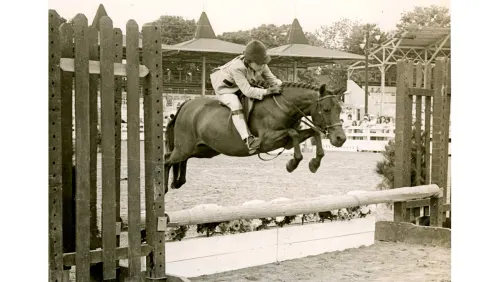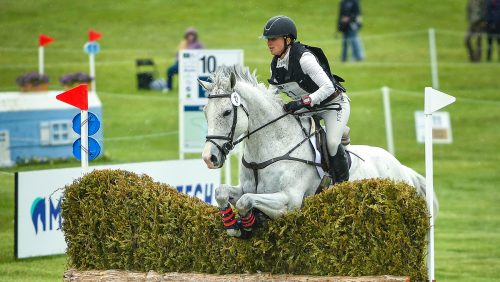When Rolex Kentucky CCI**** course designer Derek Di Grazia gazes across the rolling fields of the Kentucky Horse Park, his eyes follow the well-worn track of the toughest cross-country course in the United States.
But if he squints hard enough, he can picture the features and fences long since forgotten from when he galloped across the hallowed grounds in 1985 on Sasquatch and won the three-day event, then a three-star.
It’s been 30 years, but Di Grazia still remembers the joy of his first big win on a dream weekend where everything came together.
“I wish I remembered more!” he said with a laugh. “I have a lot of good memories of riding the horse and going on the different trips we went on, but at the same time, the things you do remember are the fact that he had a great weekend. It’s one of those things where you go and you put in the test that you wanted to put in and you’re able to keep the whole thing together and go on and do well. That’s one of those things you hope for every time you go out and it all sort of came together on that weekend.”
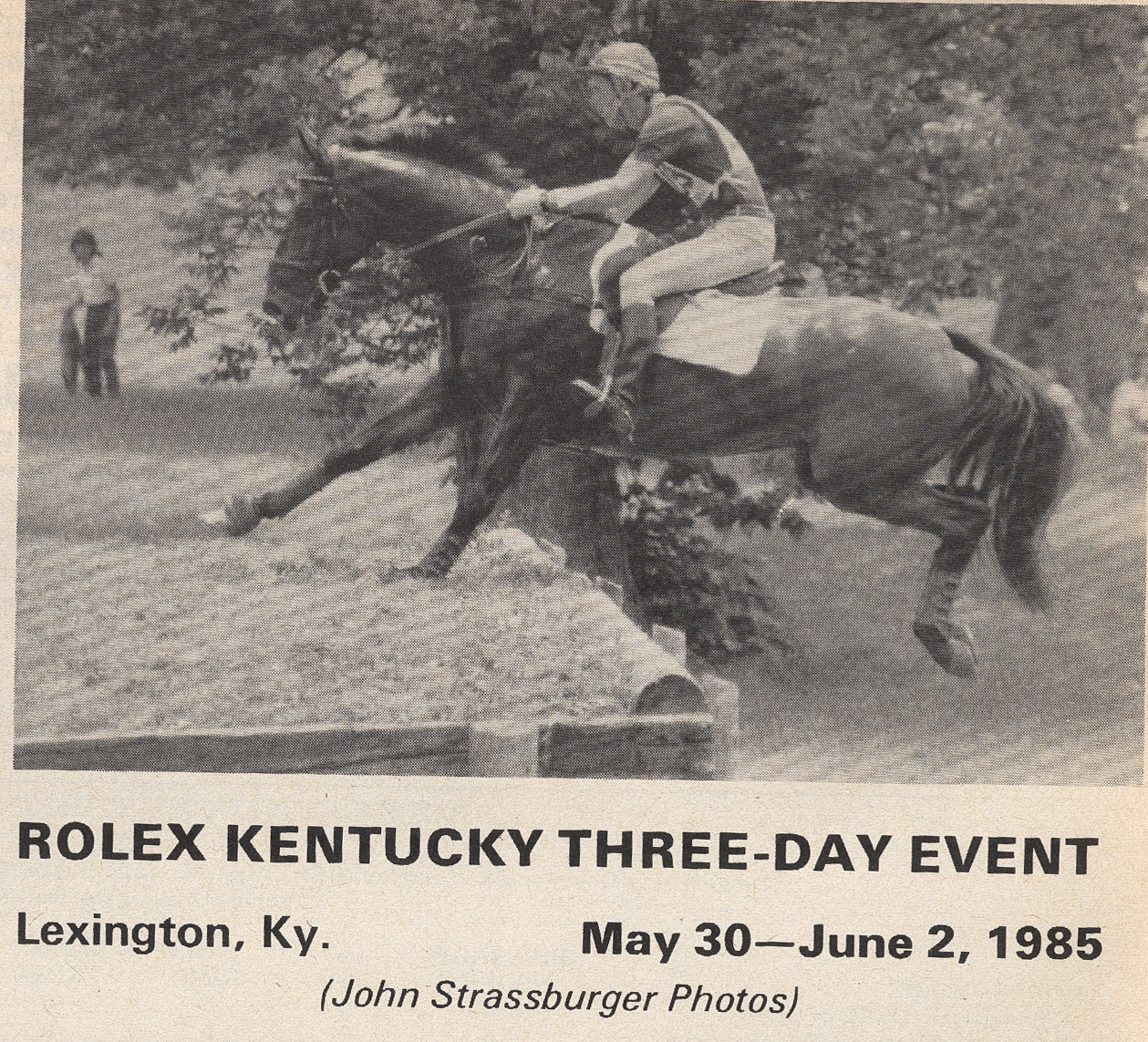
The Chronicle’s coverage of Rolex Kentucky in 1985 included this photo of Di Grazia and Sasquatch.
While the details have grown a bit hazy with time, Di Grazia’s win signified a huge moment in his eventing career. After leading Rolex from start to finish, he was chosen to represent the United States at the 1986 World Eventing Championships in Gawler, Australia.
Di Grazia got the ride on Sasquatch, a Thoroughbred/Appaloosa cross (Quinta’s Playboy—Sweet Surprise) about three years before his big win when the gelding’s owner, Linda Christensen, offered to let Di Grazia campaign him. He’d competed through preliminary with Christensen, and Di Grazia was a successful professional at the time based at the Pebble Beach Equestrian Center in California with his wife, Bea.
At the time, Christensen was working as a secretary and leading guided trail rides at Pebble Beach. She’d been asked to try riding the gelding by the mother of a boarder at the barn when he was having trouble with him.
“I rode him once, and I just came home to my husband and said, ‘I’ve got to buy this horse, I don’t care what he costs.’ I gathered all my money and walked into the office and laid it on the desk and said, ‘I would like to buy that horse,’ and she took it,” she said.
“He was like riding a Cadillac,” she remembered. “He had a lot of go and ‘I want to jump’ in him. He was a goer, and whatever you aimed him at, he jumped. We used to always make the joke that he would jump a car if you aimed him at it.”
Sasquatch earned his name because of his big feet. He had a tendency to jump out of his paddock when he thought it was time to come in and was deathly afraid of clippers.
Christensen was preparing to compete in the Western DeBroke Preliminary Championships when she hurt her back. Knowing and admiring Derek, she asked him to take the ride a week before the event, and he ended up winning it.
After that, Christensen let Derek take over the ride to see how far Sasquatch would go. Having broken out onto the eventing scene in 1977 with Thriller II, Derek was happy to have another horse to add to his string, but Sasquatch didn’t exactly scream “Rolex potential” when he came to his barn.
ADVERTISEMENT
“You wouldn’t know [he was an Appaloosa cross] from looking at him because he was a solid bay horse,” he said. “He was a good jumper. Over time, his dressage became quite good and he learned a lot. The more I worked with him, the more it showed that he had more talent and ability than we had ever thought.”
Derek spent much of his time training at home in California under Bea’s watchful eye, but he brought Sasquatch east to train with the U.S. Eventing Team at Hamilton Farm in New Jersey before Rolex.
He’d contested the event the year before, when the gelding was 9, but had a fall on cross-country and retired on course.
In the lead up to Rolex in 1985, the pair finished fifth at Ship’s Quarters (Md.) but weren’t heavily favored to win. Bruce Davidson, having taken the top three placings at Ship’s Quarters two weeks prior, had two rides at Rolex that year, but Derek scored a 40.6 in dressage and never looked back.
“At that time, we were going back and forth across the country to the West Coast, so I did all my preparation at home in the west and got him ready to come back in 1985,” said Derek. “At that point, we’d been working on things, and he had a year more experience under his belt, so I felt he was really ready to do a good job. The flat work had come along quite a lot.”
Back then, Rolex was held later, on May 30-June 2. The ground was hard, and the weather hot and sticky. To make matters worse, Derek was battling an allergy attack, something he still suffers from today on occasion.
Derek and Sasquatch had some impressive company to contest with that weekend, which included Davidson on Doctor Peaches, Mike Huber on Gold Chip, Torrance Fleischmann on Curragh, Mike Plumb with Blue Stone and Kim Walnes on The Gray Goose, former Rolex winners who were making their comeback after a crashing fall at Badminton (England) two years before.
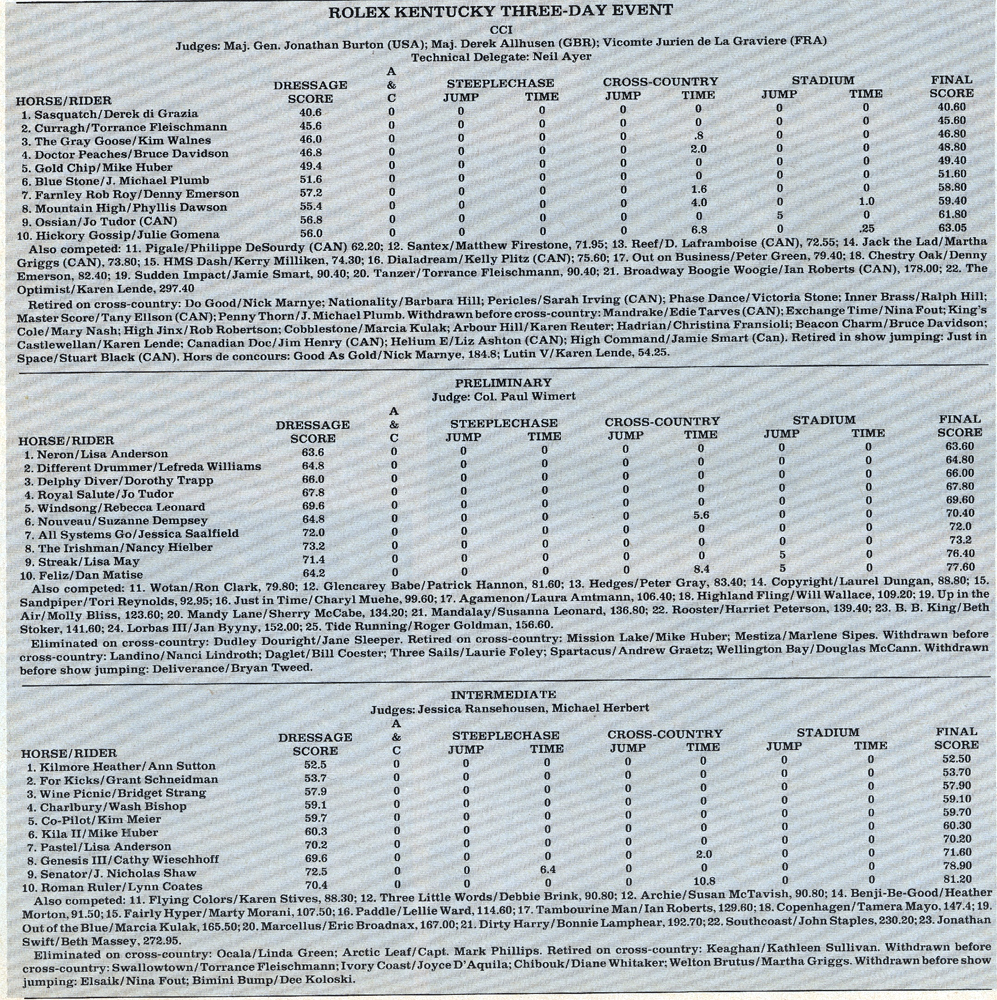
The results of the 1985 Rolex Kentucky CCI read like a who’s who of ’80s eventing.
“It is the biggest event in this country, and it always has been,” he said. “When you go there, for that time, it was a big deal. It was all the atmosphere that you have in an event of that sort. It’s a huge thing to be able to go and not only compete, but do well in a competition like that.”
The cross-country, designed by Richard Newton, was described by some riders as a bit easy, but it still took its toll, with 21 of 44 starters withdrawn or retired on course.
Event officials and spectators held their breaths for a good day on cross-country, as a rider had been killed on course two years before, but it was an overall safe day. Both Mike Huber and Mike Plumb separated their shoulders in falls, but were otherwise fine.
Derek and Sasquatch stormed around the course and show jumped clear the next day to finish on their dressage score ahead of Fleischmann and Curragh and Walnes and The Gray Goose. Derek took home $6,000 for his efforts.
Christensen was in attendance to watch her horse win and was “grinning from ear to ear.”
ADVERTISEMENT
“I remember a bullfinch they had on cross-country,” she said. “The horse had never jumped a bullfinch, and I said to Derek, ‘You know, he’s going to go to the top of that bullfinch,’ and he said, ‘No, he’ll push his legs through it.’ I sat at that jump, and he went to the top!
“I was absolutely blown away. They were such a good match, and the horse really liked Derek,” she continued. “They were a good team together. The horse had an awful lot of go and was powerful. If anything, he thought he could fly. He was that kind of horse.”
Derek remembered a very bold cross-country horse that he could count on.
“He was very straightforward on cross-country, and there was never a question in his mind,” he said. “He always wanted to jump the jumps. For him, it was learning the footwork and learning how to do the technical exercises more so than anything else. He had the desire and ability.
“For me, it was a big win,” he continued. “I’d competed in it a number of times prior on other horses and had placed well, but never won. It was the biggest win I had to date and was a huge thing for me.”
After their win, Derek and Sasquatch went on to compete at the World Championships the following year, but they had a fall on the flat when the gelding lost both his front shoes. They then fell at fence 23, a big oxer, when Sasquatch took off from too far away.
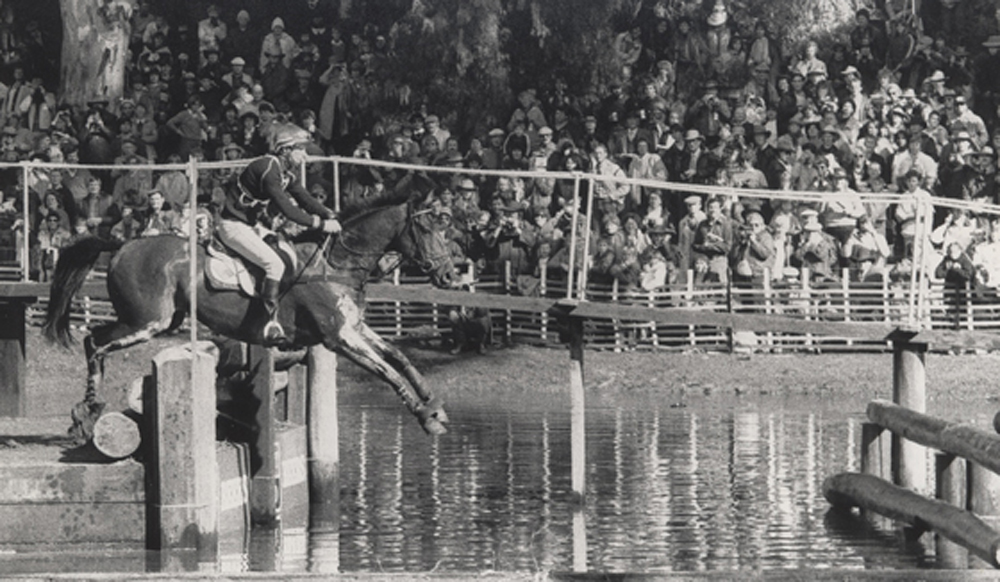
Derek Di Grazia and Sasquatch at the 1986 World Championships.
He escaped with what seemed like minor cuts and scrapes, and Derek walked away, but after being checked out by vets, it was determined Sasquatch had injured his stifle and would need six months off.
Christensen gave him more time to recover at her farm in Carmel, Calif., and decided to keep him with her to campaign in the jumpers. Sasquatch died of colic at age 17.
“I told my husband I had another lover!” said Christensen with a laugh. “He was always fun to ride, and you could go anywhere with him. He never questioned you. He was the horse of my dreams. I’ve owned a lot of horses and bred many, and I’ve never found one that was as able and amicable and trustworthy to jump as that horse was.”
In the years since his Rolex win, Derek has remained involved with the Horse Park, whether riding or designing courses. He took over the Rolex course design in 2011 and can’t help but think of his time spent there with Sasquatch as he drives through the iconic gates.
“He was right up there with some of the other good horses I’ve had,” he said. “He was a great horse for me, especially then, because I’d come off of having a very good horse who was at the end of his career, and I didn’t have another one at that time. It was a great thing for me to get such a nice horse to go on with. I was very appreciative that Linda let me take the horse and compete him.”








